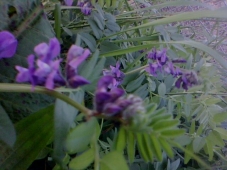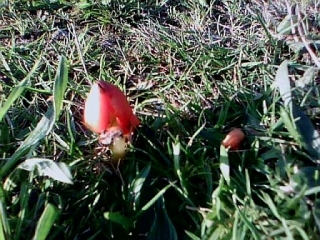Voice’s Suzanne Kelly explores the functions of wild meadows in Britain, looks at some of the existing meadows in Aberdeen and what the authorities have planned for those areas.
‘We must have a tree for every citizen” is the battle cry of Aileen Malone, a ranger or two (who also think we will make money from the trees), one or two people who are involved with the forestry industry and some political pundits.
They are willing to kill the Tullos Hill Roe deer, discard our bronze age (and later) archaeology, displace birds and insects, remove gorse and wildflowers from Tullos Hill, and spray weed-killer for 2-3 years.
Never mind that they have previously failed.
Forget that Mother Nature has left this windswept, exposed hill as a grassy meadow: these experts will try a second time with our tax money to impose a new biosystem over the biosystem which exists on Tullos.
They consulted experts, so Valerie Watts, Peter Leonard and Aileen Malone keep insisting, and no other experts’ opinions (however valid, whether freely offered or not) are wanted. This refusal to entertain other advice or to compromise whatsoever calls into question their claim to scientific superiority. Additional flaws and omissions from initial submissions leak out constantly, but the tree and cull proponents will not budge. Not willingly anyway.
But what other options are there for Tullos Hill and for Aberdeen?
There is a new breed of expert and new school of thought, backed by virtually every environmental agency in the UK and by Europe. This wave of expert opinion says that our meadows and grasslands are absolutely vital.
So before we allow politicians and career-builders decide the fate of Tullos Hill, its flora, fauna and archaeology, let’s just for a moment or two entertain a different vision for Tullos: a meadow and deer park, enhanced with more wildflowers and plants, and with protection from arsonists increased.
It is not impossible; it certainly would not be as expensive as imposing 89,000 trees.
By the way, the deer cull is not enough. Weed killers – we don’t know what kind or how toxic – are recommended by one arm of experts for two to three years. Cost: unknown. Toxicity: unknown. Effectiveness: unknown.
Who are these people claiming meadows and grasslands are not only desirable but definitely essential?
Since the 1930s, we have lost 98% (over three million hectares) of wildflower meadows across England and Wales
Plantlife (www.plantlife.org.uk ) is the UK’s leading charity working to protect wild plants and their habitats.
They identify and conserve sites of exceptional importance, rescue wild plants from the brink of extinction, and ensure that common plants do not become rare in the wild.
Here is what they have to say on the importance of meadows and grasslands – like Tullos Hill:
“These are arguably the UK’s most threatened habitats. They are rich in wildlife, landscape character, folklore and archaeology, and they offer a range of ‘services’ to society and the environment. Despite this, our wildflower meadows have suffered catastrophic declines over the past century and intense pressures continue to threaten those that remain.
“Since the 1930s, we have lost 98% (over three million hectares) of wildflower meadows across England and Wales. Wildflower meadows now comprise less than 1% of the UK’s total land area.
“Despite some good work being carried out to restore wildflower meadows, the trend continues to be an overall decline in extent and condition of these habitats. The Countryside Survey 2000 showed a decrease of a further 280,000 hectares of wildflower meadows in the UK between 1990 and 1998. The survey also showed a continuing decline in the species diversity of these habitats.
“Once lost, our species-rich meadows and grasslands cannot easily be restored.
Susan Kerry Bedell, Funding Manager for Saving Our Magnificent Meadows, has corresponded with me about the need for protecting our remaining meadow lands. She has sent me a summary document which can be found at
[http://www.plantlife.org.uk/campaigns/saving_our_magnificent_meadows/ (NB The summary will be put up in the next couple of weeks). The summary paper stems from a three-year project funded by Natural England, Countryside Council for Wales, Scottish Natural Heritage, Northern Ireland Environment Agency and Plantlife. Some of its key messages are:-
- Wildflower-rich grasslands are arguably the UK’s most threatened habitat. They are recognised as precious and important ecosystems, supporting a rich diversity of wild plants and animals, including many rare and declining species.
- These habitats are increasingly seen as contributing to the overall well-being of our society, and to the ‘services’ that healthy ecosystems provide, such as carbon sequestration (capture), amelioration of flooding and a more efficient cycle of nutrients which improves soil health and productivity.
- Wildflower-rich grasslands also offer a wide-range of public health benefits and are part of our cultural heritage, helping to provide a ‘sense of place’. They are seen as vital to the long-term survival of bees, through whose pollination of crops much of our food production depends.
Despite their high nature conservation value, our wildflower-rich grasslands are in decline, both in extent and in quality. Many of our meadows in the UK were lost during the last century.
Intense pressure, particularly from changes in farming practices, as well as development and neglect, continue to impact on the remaining areas. Between 1930s and 1980s, 98% (three million hectares) of wildflower-rich grasslands in England and Wales were lost.
Despite conservation legislation, including an EU Habitats Directive (which incorporates six BAP priority grassland types in Annex 1), planning legislation and two decades of agri-environment schemes, wildflower-rich grasslands continue to disappear or decline in condition.
Once lost, these species-rich meadows cannot easily be recreated.
- These declines meant that the UK was unable to meet its national and international commitments to halt the loss of grassland habitat and species biodiversity by 2010.
What can you do to help reverse this decline in meadowlands and grasslands?
- Visit http://www.plantlife.org.uk for more facts, ideas, and to make a donation if you can
- Visit http://www.grasslands-trust.org/
- Do you have a garden? However small it is, you can help wildlife. Various ideas can be found at https://www.rspb.org.uk/wildlife/wildlifegarden/ and http://www.snh.gov.uk/about-scotlands-nature/habitats-and-ecosystems/greenspaces-and-gardens/wildlife-in-gardens-and-allotments/gardening-for-biodiversity-at-home/
- Write to your local elected representatives and let them know how important our remaining meadows and grasslands are.
Forests are wonderful. And so are Meadows. We need both, and not just one or the other.
Finally, I am launching a petition to keep Tullos Hill the wildlife-supporting meadow it is, stop the tree planting scheme, and to stop any cull. If you would like to sign, or get a copy of the petition to collect signatures on, please contact me via Aberdeen Voice ( Link )



No Responses to “Forests Not The Only Ecosystems: The Case For Meadows”